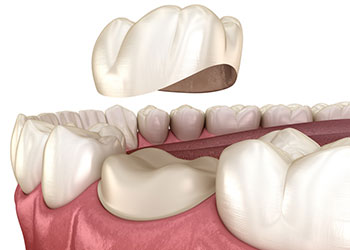
Crowns and Bridges
Crowns and bridges are cemented into place and cannot be removed, making them fixed dental prosthetics. Bridges are used to replace one or more missing teeth, whereas crowns are used to protect teeth that have been damaged due to trauma or decay. Bridges are made up of a number of crowns, while crowns are made up of a single "cap" that is glued over a broken tooth. Bridges are attached to the teeth that are still present and span the gaps caused by lost teeth.
Crown types:
Temporary crowns: are comprised of acrylic or stainless steel and are only worn while your permanent crown is being produced by the dental lab. You may or may not be given a temporary crown to wear, depending on the type of dental crown you choose.
All ceramic or all porcelain crowns: made entirely of ceramic or porcelain, these crowns have the most aesthetically pleasing appearance and can even be color-matched to your natural teeth. If you have a metal allergy, they are also an excellent dental crown choice.
All-resin crowns: are one of the most cost-effective crown choices. Resin crowns, on the other hand, are more prone to breaking than other types of dental crowns and may require more frequent replacement.
Porcelain fused to metal: dental crowns include a metal shell with a porcelain overlay and are popular for their durability and aesthetics. The opposing teeth, on the other hand, may wear down more quickly than usual. Additionally, the porcelain can chip and the metal can come through on occasion.
Metal: Dental crowns comprised of gold, platinum, and base-metal alloys like cobalt-chromium and nickel-chromium are known as metal crowns. Metal dental crowns are resistant to chipping and have a long lifespan. They are usually exclusively utilized in the rear teeth because of their metallic appearance.
Types of bridges:
Traditional Bridge: Crowns are placed on the teeth adjacent to the missing tooth, and a pontic, or prosthetic tooth, is implanted in between them. The most popular type of dental bridge is this one.
Maryland Bonded Bridge: : composed of porcelain, porcelain fused to metal, or plastic teeth and gums are used in a bonded bridge, which is supported by a metal framework. This type of bridge is frequently attached to only one side of the missing tooth.
Cantilever Bridge: When just one side of adjacent teeth is present, a dental bridge called a cantilever bridge is used. This sort of bridge, on the other hand, is rarely utilized and not advised for use in the back of the mouth.

